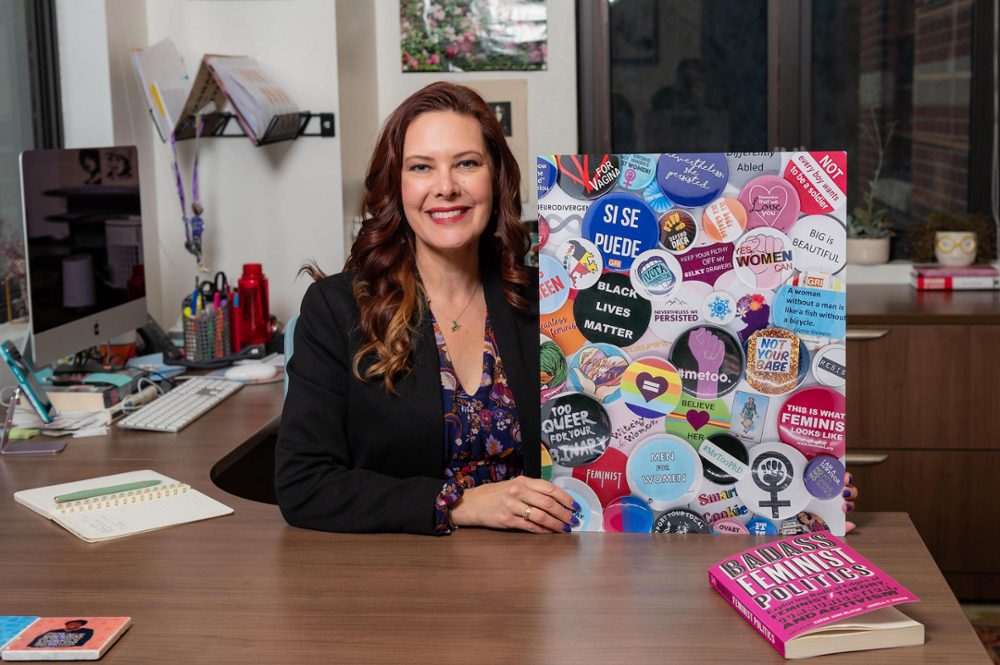Journalism & Public Relations Chair Helps Pave the Way for Feminist Activism
“Badass Feminist Politics: Exploring Radical Edges of Feminist Theory, Communication, and Activism,” co-edited by Janell Bauer, Journalism and Public Relations chair, that was definitely the case. Bauer, alongside co-editor Sarah Jane Blithe, spent years finding contributors to share their views on feminism.

Publishing a book can be a long endeavor years in the making. For “Badass Feminist Politics: Exploring Radical Edges of Feminist Theory, Communication, and Activism,” co-edited by Janell Bauer, Journalism and Public Relations chair, that was definitely the case. Bauer, alongside co-editor Sarah Jane Blithe, spent years finding contributors to share their views on feminism.
Bauer and Blithe met in graduate school and often discussed what it meant to not only study or teach feminism, but also live it. Throughout their educational and professional careers, both women faced gender-related obstacles. Those situations began to reveal the challenges women face in the workplace, in education, and life in general.
Through the Organization for the Study of Communication Language, and Gender (OSCLG), Bauer and Blithe found their opportunity to be heard. Blithe, who was then a professor at the University of Reno, Nevada, suggested they host OSCLG’s annual women's studies conference. The theme was “nevertheless, we persisted,” and attendees were invited to submit their essays on feminist theory, communication and activism.
The book offers its own definition of “badass feminism,” eradicating stereotypical and restrictive views of both terms.
“Badass referred to a typical type of tough-guy masculinity that was decidedly unfeminist,” the book reads. “Reclaimed by women, ‘badass’ is now used to celebrate, appreciate, and collectively demand gender equality.”
The book takes an intersectional approach to feminism, theorizing that multiple forms of oppression intersect with each other in complicated ways.
“One of the things we really wanted to do in the book is get people to think about these different ways that feminist politics are enacted,” Bauer said. “There are three different chapters on body image, and body expectations. There's one about health and wellness and physical conditions, and then another chapter about gender violence and sexual aggression.”
The book also features a chapter on digital spaces and activism through social media. As Bauer and Blithe started on their book proposal, the COVID-19 pandemic hit, followed by a resurgence of the Black Lives Matter movement and conversations of police brutality. It became clear that they needed to add a section dedicated to the theme of Black Lives Matter.
Book contributor Siobhan Smith-Jones, who wrote about systemic racism and social justice, was grateful for a space to share her thoughts and experiences.
“The book gave my co-author and I a place and space to communicate frustrations that we’d been feeling around the pandemic, Black Lives Matter, and the socio-political flurry that happened around them. It also gave us the chance to articulate how we see activism in our own lives,” she said.
Many of the essays touched on a similar call of engaging in activism in small, day-to-day ways.
Rebecca Mercado Jones, whose contribution fell under the gender violence and sexual aggression category, has studied both academic and practical approaches to feminism. In her own life, she noticed a “split” or divide among individuals who identify as feminist.
The split can be exclusionary depending on gender, race, class, or ability. For her, the book can be a starting point towards more progressive and unifying thoughts.
“I recall going to a chicana feminism conference in my undergrad and hearing about how Latinas were often asked to leave rallies, protests, and conferences during the early years of the movement because our culture tends to ‘cater to our men’” she said. “Feminism takes many forms and should concern itself with all forms of oppression….I think the book can respond to those complexities and more.”
 In 2022, the National Communication Association's Applied Communication Division awarded the collection of bold and honest essays the Distinguished Edited Book of the Year Award, further carrying the voices of the book’s contributors. As for the complexities of intersectional feminism, the book does more than present thoughts and perspectives. It also encourages community discussion through questions listed at the end of each chapter.
In 2022, the National Communication Association's Applied Communication Division awarded the collection of bold and honest essays the Distinguished Edited Book of the Year Award, further carrying the voices of the book’s contributors. As for the complexities of intersectional feminism, the book does more than present thoughts and perspectives. It also encourages community discussion through questions listed at the end of each chapter.
Bauer notes that these prompts are specifically designed to help students think about different issues related to gender, sexuality, identity, and intersectional feminism.
The book’s themes and subjects are already woven into the Journalism and Public Relations department’s curriculum.
“Throughout our journalism program, our goal is to make gender equity, racial equity, diversity, and inclusion, very much part of the curriculum throughout,” Bauer said. “Even in my writing for public relations classes, we're talking about how to research and write about different populations of people in an equitable way; and of the types of biases that might come up in pure writing and reporting around these issues.”
Bauer, who has taught on gender, sexuality and identity before, plans to use the book in future courses at Chico State and to continue sharing the ever-evolving knowledge she has gained on feminism, in hopes that future generations will do the same.
---
See what else Janell is up to at Chico State and in her own life in this Chico State Today article.
